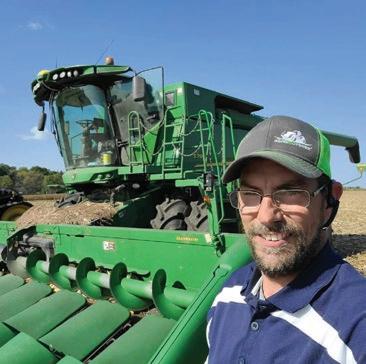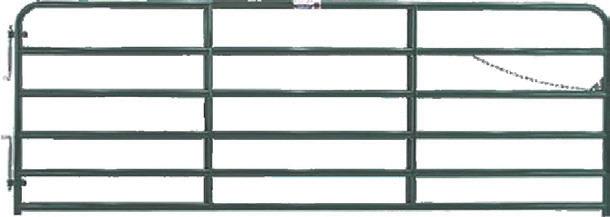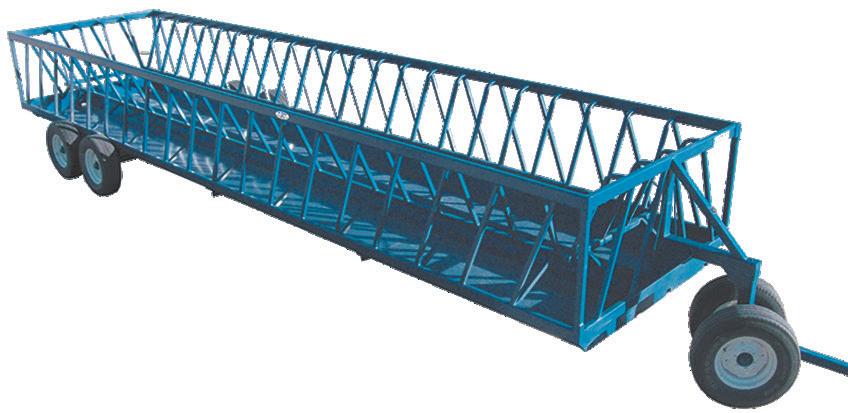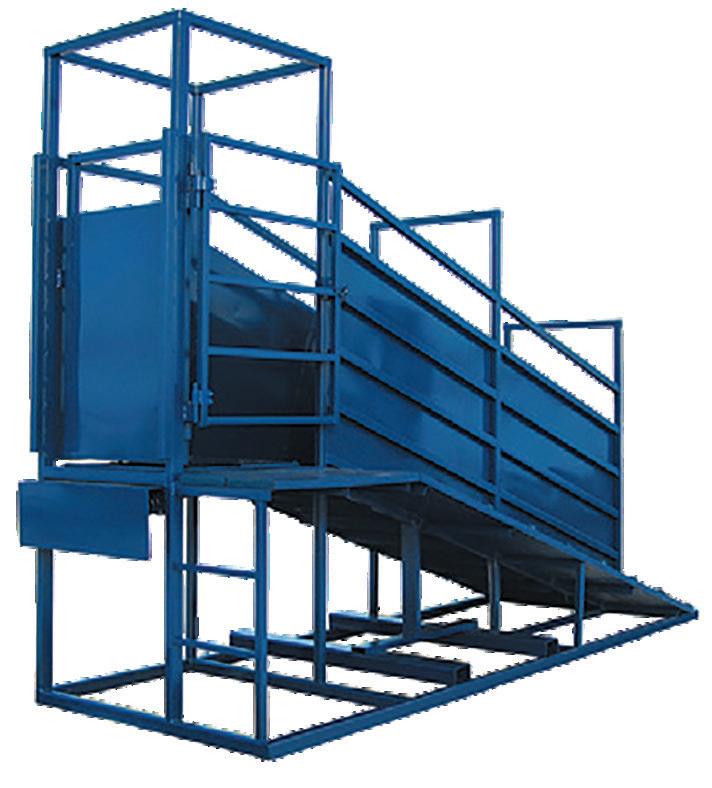












Despite historic flooding, Clay County Fair is coming to town
By KAREN SCHWALLER Farm News writer
SPENCER — The Clay County Fair in Spencer will host its nineday run Sept. 7-15, with the theme, “Clay County Fair: See It, Believe It.” The Clay County Fair typically sees 300,000 people or more annually.
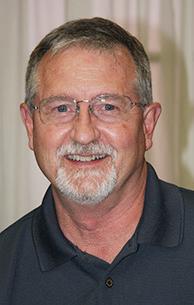
Fair Manager Jerome Hertel, in his second year in the manager’s seat, said the theme is appropriate for the kind of year Spencer residents have endured, following historic flooding that ravaged Spencer homes, businesses and farm land this past June.
Hertel said it left Spencer people wondering what would become of their lives, and throngs in outlying areas wondering if there would be a fair.
“This theme is quite appropriate with all of the flooding that happened,” said Hertel.
“We heard people wondering if the fair was going to happen, but we were fortunate that the fairgrounds didn’t suffer any damage at all.”
Fairgrounds TransFormaTion
Hertel said since the fairgrounds remained unscathed, it became a headquarters for disaster relief, with offices and spaces for FEMA, American Red Cross to set up a shelter for displaced persons, Iowa Department of Transportation, Iowa Department of Public Safety to set up their emergency 911 call center, and other disaster relief entities to set up — including temporary housing in the north parking lot. It also offered (across the street to the north of the fairgrounds) an area for flooded home and business refuse to be taken, so people could start rebuilding their lives.
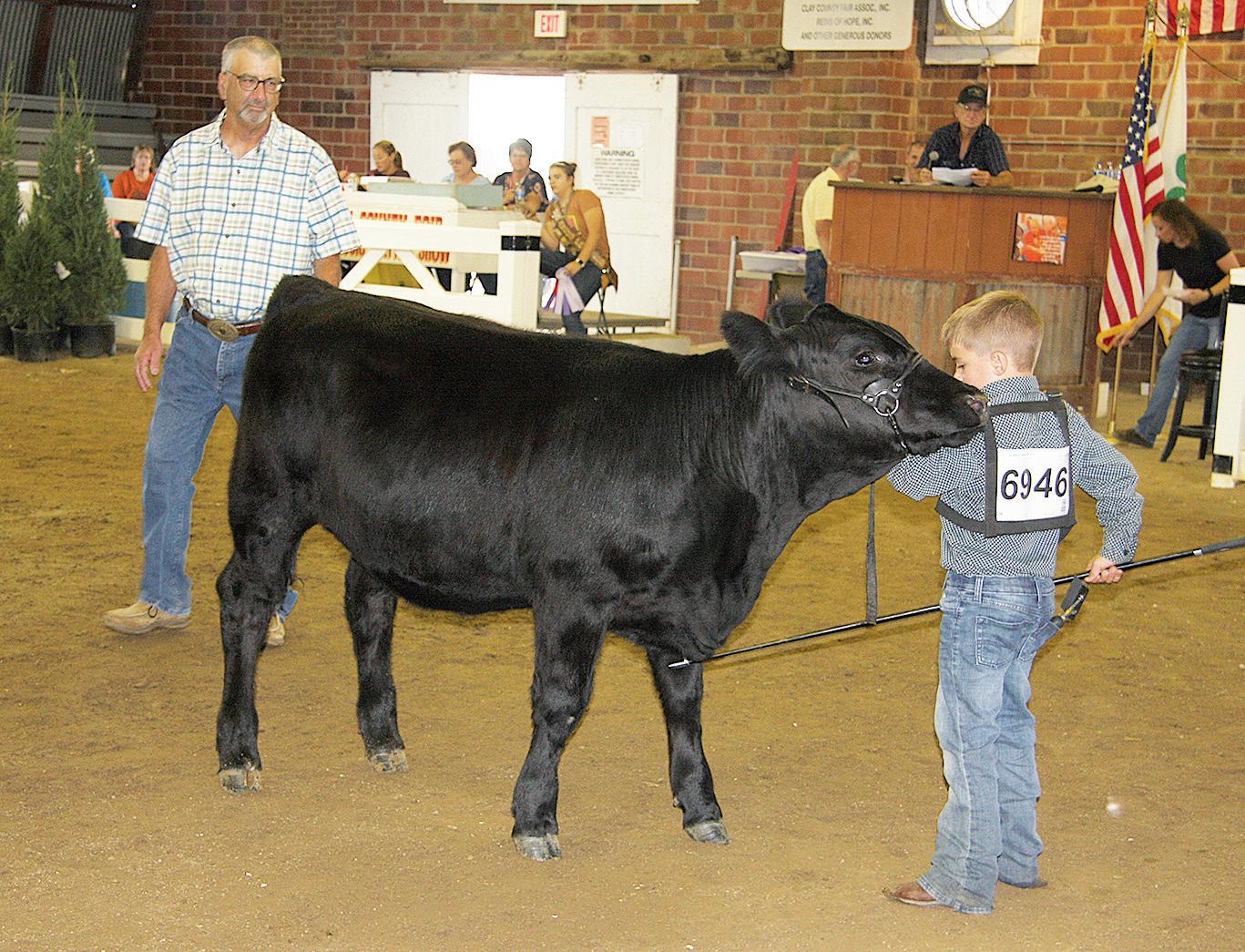

By DARCY DOUGHERTY MAULSBY Farm News writer
While there were plenty of vintage John Deere tractors on display at the 2024 Albert City Threshermen and Collectors Show Aug. 9-11, one tractor had celebrated its 100th birthday just weeks before the big event — and it attracted plenty of attention.
“This is a 1924 John Deere D with a 26-inch flywheel,” said Chris Cobler of Ottumwa, who owns this remarkable tractor. Nicknamed the Spoker D
for its spoked flywheel, the John Deere Model D offered power, sturdiness and reliability for farmers in the early 20th century. Introduced in 1923, the John Deere Model D became the first tractor built, marketed and named John Deere. It replaced the Waterloo Boy in the company’s product line.
“Deere made about 50 Model D’s in 1923 and 750 in 1924,” said Cobler, whose tractor was manufactured in Waterloo, Iowa.
His tractor’s two-cylinder engine produces 15 horsepower at the drawbar and 27 on the pulley. In the mid-1920s, a farmer could obtain a Model D for about $1,000. [That’s






celebrates 20th Year as Iowa’s No. 1 Ag Bank
CEO: The right attitude and the right people are key to success
By DOUG CLOUGH Farm News writer
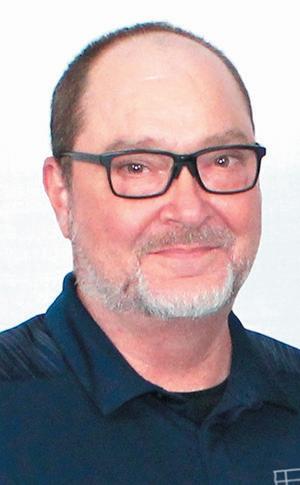

IDA GROVE — When United Bank of Iowa (UBI) was first named “Iowa’s No. 1 Ag Bank” in 2005 by the American Bankers Association, then President and CEO Ken Van Kekerix attributed the distinction to three attributes: the right attitude and the right people; the desire to figure out how to make the right loan work; and being in rural Iowa where agriculture is abundant. Owen Bolte, the current chairman of the board who also has a background in agriculture, continued the vision of a strong commitment to agriculture while serving as president for 14 years. UBI is celebrating its 20th year as the No. 1 ag bank in Iowa, and Dan Dotzler, current president and CEO echoes the same reason these two decades later.
“Having the right people has absolutely been key,” said Dotzler. “So many of our ag lenders grew up in ag; they currently are farming or are part of a farm lineage or have a side
See UBI, Page 6A
Happy 100th birthday to this 1924 John Deere D
roughly the equivalent of $18,500 in 2024 dollars.]
The Model D was part of a whole new era of horsepower on the farm. Since the 1903 appearance of the Hart-Parr line of tractors, farmers had turned from steam-traction engines to lighter, more practical internalcombustion engine tractors. Most farmers did not need a large tractor, just one that was versatile and could do both field and belt work.
The Model D competed with McCormick-Deering, HartParr, Rumely and other major
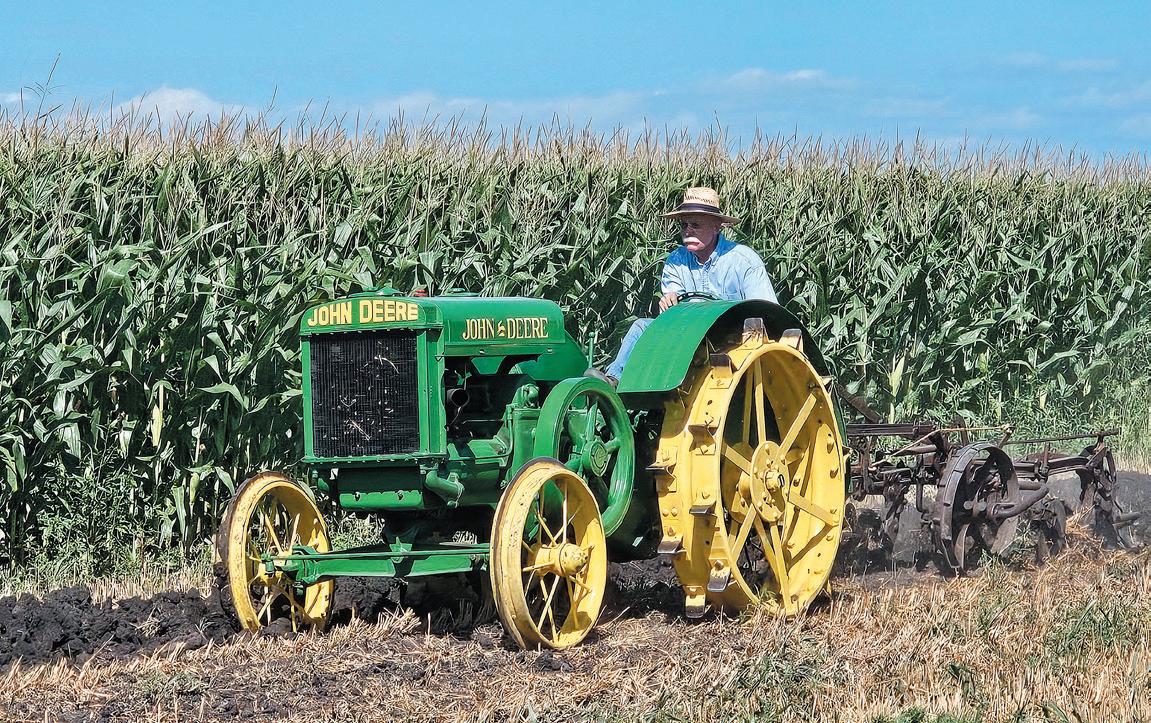
























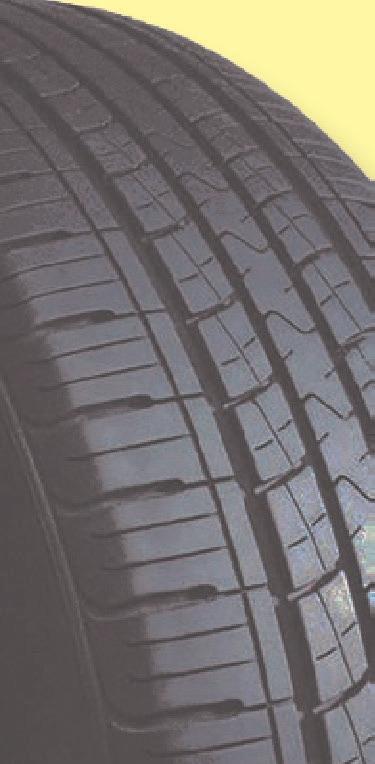



















NEWS
*NFA has permanently prohibited East West Global LLC, a former NFA Member commodity pool operator located in Glencoe, Illinois, from reapplying for membership and from acting or being listed as a principal of an NFA Member. NFA has also permanently prohibited Luke James Adrian, a former principal and associated person of East West Global, from applying for NFA membership, reapplying for NFA associate membership and from acting or being listed as a principal of an NFA Member. The BCC’s complaint alleged that East West Global and Adrian violated NFA Compliance Rules 2-2(a), 2-4, 2-29(a) and 2-29(b) by engaging in a deceptive course of conduct involving a commodity pool they operated, called iFund Diversified I, LLC (the Fund). The Complaint alleged East West Global and Adrian made material changes to the Fund that involved how the firm and Adrian used participants’ retirement funds, and which changed the entire tenor of the investment, but failed to adequately disclose the changes and their consequences to participants and failed to act in participants’ best interests. The complaint further alleges that East West Global and Adrian misled participants to believe they would receive their initial investments back, despite a substantial shortfall in the Fund, and used deceptive and misleading communications and promotional materials.
*The Commodity Futures Trading Commission issued an order simultaneously filing and settling charges against Cost Management Solutions, LLC (CMS), a Texas corporation. The order finds the respondent failed to register as an Introducing Broker (IB) and requires CMS to pay a $100,000 civil monetary penalty. The CFTC also orders CMS to cease and desist from further violating the CEA, as charged. The order finds from at least May 2018 through the present, CMS acted as an unregistered IB by soliciting and accepting orders for swap and options transactions for its clients. CMS mainly brokered transactions in energy commodities, including propane, heating oil, and crude oil. CMS’s IB activities included: identifying counterparties; price discovery; negotiating trades; and trade execution. CMS did not accept any money, securities, or property to margin, guarantee, or secure these transactions. CMS received fees from its clients for its

Midwest Marketing Solutions Brian Hoops
brokerage services.
CORN ANALYSIS
Corn closed the week $.08 1/2 lower. Last week, private exporters announced sales of 6.5 million bushels (mb) of corn to an unknown destination and 5.4 mb of corn to Mexico.
In the weekly export inspections report, U.S. corn export inspections, for the week ended Aug. 8, were 38.4 million bushels, while declining to a six-week low as the 2023-24 marketing year winds down with only three full weeks remaining. Cumulative Export Inspections of 1.926 billion bushels are up 37.1% from last year’s 1.404 billion vs. USDA estimating exports to be up 33.9% from last year.
In the weekly EIA report, U.S. ethanol production, for the week ende Aug. 9, ticked up to 1.072 million barrels/day from 1.067 mbpd the previous week and was up a minor 0.3% from last year’s same-week production of 1.069 mbpd, leaving the most-recent fourweek average production running 2.2% above year-ago levels. While this week’s year-over-year production comparison was muted relative to recent weeks, the overall production pace continues to run a bit above the “needed” pace relative to the USDA’s 5.450 billion bushel 2023-24 corn for ethanol usage estimate. U.S. ethanol stocks last week declined solidly to 23.354 million barrels from 23.767 million barrels the previous week, putting mid-August stocks right in line with those of the last two years both at 984 million gallons and modestly below record stocks for the week of 1.003 billion gallons in 2019.
In the weekly crop progress and conditions report, U.S. corn conditions came in at 67% good/ excellent vs. 66% expected, 67% last week and 59% last year. Silking is 94% complete vs. the 2019-23 average at 94%. Corn dough is 60%, 4% above the fiveyear average and 18% of the corn
is dented, 6% above the five-year average. In the supply/demand report, the USDA pegged U.S. corn yields at 183.1 bpa vs. estimates of 182.2 bpa and the July figure of 181.0 bpa. This was a new record. They revised harvested corn acres by 700,000 lower to place production at 15.147 bb. Exports were increased by 75 mb with feed usage lowered by 15 mb to put ending stocks at 2.073 bb, down from 2.097 bb last month. The stocks to usage ratio is at 13.9%, the largest since the 2019-20 marketing year. World ending stocks for 2024-25 were lowered by 1.4 mmt at 310.2 mmt vs. 311.5 mmt estimated.
Producers have established a floor with put options and put/call spread as well as making 2024 cash sales. One hundred percent protection is advised. Do not lift hedges as harvest lows have not been achieved yet.
Soybeans closed the week $.46 1/4 lower. Last week, private exporters announced sales of 4.9 mb of soybeans to China and 11.0 mb sold to an unknown destination. U.S. soybean export inspections last week were 12 mb and, while up slightly from the previous week’s 9.8 mb, soybean shipments continue to run below the roughly 15.7 mb/week average we estimate will be needed over the final three full weeks of the 202324 marketing year to reach the USDA’s 1.7 billion bushel export projection. Over the last four weeks, soybean inspections averaged 12.3 mb/week and 11.4 mb/week over the last eight weeks. Cumulative export inspections of 1.593 billion bushels are down 15.3% from last year’s 1.882 billion vs. USDA estimating exports to be down 14.1% for the year.
The crop progress report showed U.S. soybean conditions 68% good/ excellent vs. 67% expected, 68% last week and 59% last year. There was a 1% shift from the excellent to the good category. Setting pods is at 72% vs. 70% average.
In the monthly supply/demand report, the USDA increased U.S. soybean yields to 53.2 bpa from 52.0 bpa last month. They increased soybean acres by 1 million to 4.589 bb, up 154 mb from last month and increased exports by 25 mb and residual usage by 4 mb to increase ending stocks by 125 mb from last month to 560 mb from 435 mb a month ago. Soybean stocks
to usage is 12.8%, the highest since 13.3% during the 2019-20 marketing year. World ending stocks for 2024-25 increased by 6.3 mmt at 134.3 mmt vs. 128.0 mmt estimated. The NOPA crush report came in at 182.881 mb, slightly above estimates of 182.4 mb but well above last month’s 175.6 mb and last year’s 173.3 mb. Soybean oil stocks came in well below estimates at 1.499 bp vs. 1.608 bp estimated, 1.622 bp last month and 1.527 bp last year.
STRATEGY & OUTLOOK
Producers have established a floor with put options and put/call spread as well as making 2024 cash sales. One hundred percent protection is advised. Do not lift hedges as harvest lows have not yet been achieved.
WHEAT ANALYSIS
For the week, Chicago wheat closed $13 3/4 lower and Kansas City wheat closed $.15 3/4 lower.
U.S. wheat export inspections last week were a marketing year high at 23.9 mb, rising from the previous week’s 17.3 mb and notably surpassing last year’s same-week exports of 9.9 mb. Over the last four weeks, wheat exports averaged 16.9 mb/week vs. 14.1 mb/week during the same period last year, allowing cumulative export inspections of 155 million bushels to hit a 26.7% gain vs. last year’s 122 million while the USDA’s 2024-25 825 million bushel export projection reflects an expected 33.9% increase for the year. In order to reach the USDA’s current export target, wheat shipments will need to average roughly 15.3 million bushels/week through the end of next May vs. last year’s 13.5 million/week average from this point forward.
In the weekly crop progress and conditions report, weekly spring wheat conditions were down 2% from last week at 72% good/ excellent. Conditions in the good category dropped from 63% to 59% and the excellent percentage went from 11% to 13%. Spring wheat harvest is 18% complete, up 12% from last week but 3% below average. Winter wheat harvest is 93% complete vs. 93% expected (92-95% range), 88% last week, 91% last year, 91% average.
The USDA lowered planted wheat acres by 900,000 but raised yields from 51.8 bpa to 52.2 bpa, resulting in production 26 mb lower than last month at 1.982 bb. This resulted in ending stocks
falling from 856 mb to 828 mb. Stocks-to-usage ratio is a whopping 42.2%, the highest since the 201920 campaign when it was 49.2% Spring wheat yield estimated at 52.6 bpa, down from 53.1 bpa last month and harvested acres were lowered by 555,000 acres with production lowered to 5.4381 mb from 5.7784 mb last month.
World wheat production in August totaled 798.28 MMT vs. 796.19 MMT in July. Increases were primarily seen for Australia, Kazakhstan, and Ukraine more than offsetting lower EU and U.S. production decreases.
STRATEGY & OUTLOOK
Producers have established a floor with put options and put/call spread as well as making 2024 cash sales. One hundred percent protection is advised.
LIVE & FEEDER CATTLE
ANALYSIS
Last week, live cattle closed $3.05 lower while feeder cattle closed $3.87 lower. Last week, moderate fed cattle cash trade volumes in the North at $190 live and $298 dressed, which is $3 softer live and $7 lower dressed compared to last week. Moderate trade in the South at $185 live and $293 dressed, which is mostly $1 lower live than last week. The latest USDA steer carcass weights were up 2 pounds from last week at 923 pounds, which is 28 pounds above year-ago levels. The weekly export sales report has net beef sales of 28,100 mts, a marketing year high for 2024 with shipments at 14,100 mts.
STRATEGY & OUTLOOK
Producers should have reestablished window or fence strategies to protect the downside but allow for upside potential.
LEAN HOGS
ANALYSIS
Lean hogs closed the week $1.07 higher. Iowa/southern Minnesota weekly hog weights for week ending Aug. 10 has weights down to 281.0 pounds vs. 281.6 pounds last week but still above the 277.2 pounds last year. The weekly export sales report has net pork sales of 20,900 mts, a marketing year low for 2024 with shipments of 28,800 mts.
STRATEGY & OUTLOOK
Producers should have reestablished hedges as values tested weekly chart resistance and commercials were hedging.
It is the beginning of the dog days of August where the night time temps are dropping below 50 degrees and a lot of the corn fields are acquiring more yellowing leaves. At this point any additional field applications have to be made by high clearance sprayers, airplane, or now an increasing number of drones.
Why that may be crucial to a large number of soybean producers north of U.S. Highway 20 is that the breezes came from the north during the cool twoweek time period and it has become apparent that a large influx of winged soybean aphids were carried on those breezes and ended up dropping out of the sky onto unsuspecting soybean fields and reproducing rapidly enough that the aphid counts are high enough on the leaves, stems and newly unfurled leaves are often sticky to make walking into those fields a sure thing to have to change clothes after the scouting task more uncertain. I am hearing that some growers between Iowa Highway 3 and U.S Highway 20 are now finding the higher populations in their fields.
One pertinent topic among farmers and aerial applicators is how to differentiate between aphid populations that are susceptible to pyrethroids and those that are resistant to that family of chemistry. You can find out by yourself by seeing if the bugs live or die quickly after an insecticide application.
From what I have read, there are confirmations of this resistance in much of northwest Iowa. The jury is out as to the geography of the problem. What we already knew is that insects don’t read the book and will

always surprise us. The first pyrethroids were extracted from chrysanthemums in Europe during WW II. The first synthetic compounds were commercialized in the late 1970s and they totally changed our insect control programs in that they were safer, had longer residuals and were applied at very low rates. They replace much more toxic products such as Furadan, Toxaphene and many of the Ops. Since their use has been so broad and insects, or their Gut biota can mutate so quickly with one or a few seasons, it was only a matter of time before we saw broadscale resistance.
That left many applicators who scouted their bean fields in the last week north of Iowa Highway 3 or U.S. Highway 20 finding populations up to and well over the treatment threshholds of 250 per plants. The lesson we learned in 2003 is that if moisture is short, the small sucking aphids can cause yield losses of 10 to 30 bushels per acre. Checking around, there seemed to be shortages of products labeled for uses on aphids in soybean fields. There were a few distributors who could find small quantities of a generic chlorpyriphos. The next product, which was attractively priced and was
deemed effective yet safe to beneficials, was Sefina. Since each company has to project the quantity they envision needing in the upcoming season and since it has been four or five years since we have seen treatable populations of the small, green sucking insect, they used German mentality and prefer to sell out each season, so it was a hard product to find. It is typically priced under $6/A.
The last candidate to consider using is Transform from Syngenta at $11.30. The use rates are very low.
The soybean crop status
Once we began to have warmer nighttime temps the plants put on additional growth. Many of the later planted fields in areas where the ground stayed saturated are still short and a long way from closing the rows. Morning fogs were common for about two weeks and the two most common fungal pathogens showed up. Septoria was No. 1, and No. 2 was, or is, Downey Mildew. They form small, yellowish, irregular shaped spots which have silvery hairs growing from them when examined using a hand lens. This Cercospora species is in the same family as Frogeye leaf spot.
A portion of the state had gone approximately three weeks with no rain and the plants were exhibiting moisture stress. This would have been the demand for the nutrients needed to fill the seed. If that matches what you are seeing in your area, the best course of action is to respond with an application of a multimineral product such as Foliar Blend or Ingrained. Status of the corn crop
Back in 2015 by the time of the Farm Progress Show, about 80% of the corn crop was dead and heavily lodged, to the point that the harvest demos were abandoned due to the fact that it was embarrassing to the seed companies.
The status of the corn crop is much different this year. However enough corn acres have turned from a dark green color to various shaded of yellowish green. This change is greatest in the areas where it rained every three or four days.
I took my Minolta Spad meter with me last week to take readings of the plants to see if the plants tested higher than 50. The 50 reading marks the lowest level we ever want to see the nitrogen (N) level at. In this case, we had applied two species of the Gluconoacetobacter, or ‘Envita,’ foliarly in the hopes of fixing more atmospheric N and not have to deal with applying gallons of a liquid product. When using the meter you have to shut the jaws tight until it gives you the reading sign and then shut the jaws at 3 or 4 locations of the leaves to take 3 or 4 locations on the leaf.
All fields averaged above 50 but not as I would have liked. I would have liked each field be above 60. A few did that, especially if manure had been applied.
In pulling the husks back, I saw kernels denting ahead of schedule and more inches of tip back than I had seen in previous seasons. The cause could have been too hot of temps, low sunlight and resulting low levels of photosynthates formed, or soils that went many days with low 02 levels in the soil. It would not surprise me if the same thing shows up in a high
percentage of the fields.
Fish as plant food
A newer fish fertilizer by the name of Tidal Grow is going to make its presence in the Midwest better known. We have all read how a Native American Indian named Squanto showed the colonists how to plant a seed right next to where they buried a fish. My first thoughts when hearing about using liquified fish again was that it may never catch on in the product high OM soils.
Larry Eekhoff took in few totes of the TNT fish and was hoping to get at least a few corn growers to apply a bit of it.
Well one well-known farmer was curious about how it might work and spent the money and applied it on 80 or 160 acres of corn.
How it stimulated the corn plants versus no fish was so impressive that he spent the money and applied it to all of his corn acres. They are taking weekly leaf samples for mineral analyses, and now that the ears have filled, they are measuring ear size and ear counts. It is still early and more fill is evident but the scale weights so far tell of a 72% increase in grain weight and a large increase in second ear.
On some of his acres they have only applied 60
pounds of N. They will be summarizing the results at winter meetings this coming winter. Now if the 60 pounds of N match or beats higher rates of N, they will have to develop new field trials to see what additional steps could be added to return ever higher ROIs.
Tar spot
As expected, there are more reports of tar spot appearing in different parts of the state and in more states.
I just took a call from a client near Monroe, Wisconsin. It is appearing in only the one field which received 6,500 gallons of dairy manure, which would have contained the normal amount of Gly, which would be .75 pounds/1,000 gallons manure. We now know that an application of Paleo Biotica’s microbial mix may need to be applied to degrade the herbicide residual in the soil prior to planting a conventional hybrid in 2025.
The Big Farm Progress Show
The days of the big show are getting closer. There has been lots of activity at the site in preparation of this biannual show. We just hope it stays sunny at 76 to 78 degrees and a light breeze.


Organizers say it’s truly a World’s Fair of Agriculture
Thousands of people will soon be converging on Boone for what is described as the largest outdoor agriculture show in the nation. That event is the 2024 Farm Progress Show to be held Aug. 27-29 at 1827 217th Road in Boone. Show hours are 8 a.m. to 4 p.m.
The show is a highlight of the summer for farm folks and others with a business interest in agriculture. It also attracts a diverse assortment of others from all parts of the world who simply want to keep up on the latest trends in farming.
With good reason, the Farm Progress Show has been characterized by its organizers as the “World’s Fair of Agriculture.” It has few rivals as a source of state-of-the-art information about just about anything related to farm life and as an opportunity to take a close-up look at the latest technology. Past shows have boasted more than 600 exhibitors.
The Farm Progress Show has been a popular event for more than six decades. It got off to a fast start on Oct. 2, 1953, on the Earl Bass farm in Armstrong, Illinois, and has continued to evolve. In recent years, the show has alternated between two sites — Boone and Decatur, Illinois.
The exhibit field will include displays and demonstrations by top agribusinesses, not only from across the United States, but also from abroad. The three-day event will include:
n Field demonstrations of harvesting and tillage.
n New product introductions.
n Assorted displays and demonstrations.
n Seed and crop technology plots.
n Marketing seminars.
n Cattle handling demonstrations.
n Equine events and much, much more.
Mark your calendars now.
The 2024 Farm Progress Show is an event no one with even a casual interest in the world of agriculture will want to miss.
After reading the Farm News Aug. 8th column by David Kruse concerning the controversy over carbon pipelines, eminent domain and water usage, it is kind of like reading about a chicken with its head cut off!
The most revealing statement came from Kruse when he claimed, “Bruce Rastetter is politically connected to the governor and elected officials because they have the same collective vision for economic development of the state.” Carbon pipelines are not visionary; they constitute reckless resource extractionism!
Commenting on Bonnie Ewoldt s Aug. 8 letter, it is a huge mistake for her, and grassroots organizations like the Sierra Club and Iowa Citizens for Community Improvement, failure to emphasize that any carbon capture by ethanol production has been washed out due to the loss of family farm livestock production with all its lost carbon sequestering!
Plowing up of long-established pastures, destruction of small timber areas that protected and shaded cattle herds, the loss of oat, alfalfa and clover production that stored carbon and cleansed the soil had — and has — a huge impact concerning carbon sequestering. Think of more crop production with more fossil fuel, more pollution, more soil loss.
Yep that s what the loss of family farm livestock accomplished because like Gov. Kim Reynolds, exGov. Branstad had a destructive visionary moment when he signed House File 519 into law that unleashed giant agribusiness CAFO factory farming onto the state.
Bonnie’s other glaring omission is that Summit Farms is getting its grain dirt cheap because there is no parity price floor on corn, and Bruce (Rastetter) is milking that for all its worth plus he is salivating over the potential government cash cow coming from carbon credits.
If the governor, state legislatures, Sens. Grassley and Ernst, and Rastetter are so visionary, why are we selling our collective investment (grain production on the cheap at the farmgate)?
If the price drop holds after this fall, farmers and the whole grain industry will lose billions across the country! I do not see Rastetter rallying for family farmers and railing against below costs of production for corn or beans. Where is his collective vision for family farmers and those laid-off John Deere and Firestone workers? Yeah, where is David Kruse on the subject of cheap grains?
Pardon me for asking the obvious, but is Iowa’s agriculture industry so flush with cash that it can afford to lose billions of dollars on its grain production this fall?
Calculating the $4 drop in corn prices since last year, if Iowa farmers produce 2 billion bushels of corn this year that is an $8 billion loss at the farmgate!
I am afraid those folks who are fighting Summit Farms will continue to lose unless they re-focus on the huge loss of family farm livestock production and the failure of this nation’s leadership to establish the parity formula on cash grains.
If the governor and our state legislature were so visionary, they would abolish agribusiness large scale CAFO factory farming and re-establish the diversified family farm crop and livestock system using the parity formula price floor on grains and supply management. If not, then we can only assume the economic and environmental destruction will continue and Rastetter will happily receive his cash cow (cheap grains), Reynolds will continue to receive her political gifts from Rastetter, and carbon pipelines will be the reality!
Larry Ginter Rhodes

Rain makes grain, and two midAugust Department of Agriculture reports offered this year’s first inthe-field look at just how much corn, soybeans and wheat — as well as other crops like sugar and cotton — American farmers will grow this wet, grain-making year.
On Aug. 12, USDA estimated that the 2024 U.S. corn crop would total 15.1 billion bushels (bu.), a small decline from a year ago but still the third largest crop ever. A record per acre national yield, pegged at 183.1 bu., is almost 6 bu. more per acre than in 2023.
High production usually means low prices and USDA estimates the 2024-25 corn crop’s average price will slump to $4.20 per bu., 45 cents per bu. lower than the about-toend current crop year and a walletthumping $2.34 per bu. under 202223’s average of $6.54.
Bigger production also means bigger ending stocks, but falling prices can trim the rising stockpile if they spur new buying. USDA does not see that happening in the coming year. Worse, ethanol makers will use the same amount of corn this year as last, 5.45 bill bu., while exports will climb an almost imperceptible 50 million bu.
That means ending corn stocks a year from now will be 2.07 billion bu., or 10 percent more than today. That’s a tough hill for weakened prices to climb. The coming soybean crop,
according to USDA bean counters, will be a whopper: Total 2024-25 U.S. soy production will set an alltime record, 4.6 billion bu., or 10 percent over a year ago. Estimated national yield per acre will also be a whopper: 53.2 bu.

Alan Guebert
But the staggering crop will bring a price-busting carryover of 560 million bu., or almost 220 million bu. more than this marketing year, and a projected $10.80 per bu. average price, $1.70 under the current year’s average and a jarring $3.40 per bu. less than two years ago.
A key part of that price drop hinges on continued increases in global oilseed production, notes USDA. Worldwide, soy and rapeseed production will increase an estimated 4.5 million tons — mostly due to acreage increases in Russia, Ukraine, India, and west Africa’s agdominated Benin. That anticipated production is already knee-capping U.S. prices.
U.S. wheat producers face the same hill as corn and soybeans despite fewer 2024 planted acres. Better yields, however, kicked production to 2 billion bu., or about 170 million bu. over a year ago.
That boost — as well as growing global competition — means U.S. wheat stocks will again build as prices continue to slip throughout the coming year. For 2024-25, USDA sees all U.S. wheat prices averaging $5.70 per bu., or about $1.25 less per bu. than a year ago.
Rain also makes sugar, both cane sugar in the Deep South — principally Florida, Texas, and Louisiana —and beet sugar in the High North, mostly in Minnesota and North Dakota. Collectively, USDA estimates total 2024-25 sugar production at 9.5 million short tons.
Cotton, too, will see a steep increase in production, up an estimated 3 million, 480-pound bales, or a whopping 25 percent this year over last. Since American cotton mills are few and far between, USDA foresees 12 million bale —out of this year’s 15-million-bale crop, or 80 percent — will be exported. Stocks, however, will build to keep prices flat.
What this year’s wet weather can’t grow, however, is more income. In February, USDA projected 2024 U.S. net farm income at $116 billion, or 25 percent below 2023’s take. These August production and usage estimates strongly point to that number draining even lower when USDA revises its farm income estimate Sept. 5.
Proving once again that when it rains, it pours.
Capitalism can be brutal. One study found that of all the companies started in 1998, only 31% of them remained just seven years later. It is likely much less than that today. Another report showed that over half of Fortune 500 companies disappeared in the last 20 years. Another comparison seemed to be appropriate considering the recently concluded Paris Olympics. You might remember Carl Lewis, who dominated sprinting events in the 1984 LA Olympics. Based on his times, if he were to run today in the Olympics, he would have gotten dead last.
For me, these examples highlight the need to forever be learning, improving and evolving. While we can lament the challenges of today’s market downturn, it also can force us to improve rather than rest on our laurels. Farming has been good the last several years, but now it is our turn to go through another bottom cycle. The challenging times will force some producers out of the business while forcing others to adapt and to use it as an opportunity.
The ag industry in general is better prepared for this cycle. Land values are the bedrock upon which many solid farm operations are built, and they have proven extremely resilient. Ag lenders did not allow farmers to overextend themselves despite attractive commodity prices. This will allow them to better weather the storm. Nevertheless, when bottom cycles like these happen, the consolidation tends to speed up. Farm consolidations are not anything new. They have been happening since the USDA began recording them over 100 years ago. But that does not mean there are not things we can do to become better prepared.
Many farms are larger than a lot of store front companies on Main Street USA. This doesn’t mean we have to become corporate bureaucrats, but there are things we can learn that will help us become better managers.
That is the goal of the Family Farm Masterclass. We seek to create an educational environment where producers can network with peers and learn about strategic management skills, succession planning, entrepreneurship and of course — risk management. The Masterclass is not just a name. Commstock has organized some high-profile producers to come and share their knowledge with us. How often do you get to learn from other multi-generational
farm families that operate 20,000 acres on how they have obtained success?

I could argue that family farms have it even more challenging than non-family businesses as the dynamics among family in business add another layer of complexity. That is why we have invited Willie Robertson to be one of our key-note speakers. Robertson is well known for his TV series Duck Dynasty. We look forward to him sharing his views on how he managed the family dynamics in the company. The Family Farm Masterclass takes place Feb. 21-22, 2025, in Des Moines. Tickets can be purchased at https://commstock.com/ family-farm-master-class/ The Family Farm Masterclass will equip farmers and agricultural leaders to professionalize their management practices as well as prepare them for future growth and transitions.
SPEAKERS R. L. “DICK” WITTMANN
Dick Wittman is board chair and former manager of a 20,000acre dry land crop, range cattle and timber operation in northern Idaho. Management of the farm has transitioned to a partnership of three other family partners. He also provides private consulting to farm, ranch, and agricultural support businesses. In recent years, he has focused on trainthe-trainer workshops.
ZACH JOHNSON
Known to his 1 million-plus followers on YouTube as the “Millennial Farmer,” Johnson is a sixth-generation farmer who’s spent his life growing, working, and learning on his family’s farm. With growing consumer awareness about where their food comes from, Johnson has identified the need for an independent voice from the front lines of agriculture. He actively promotes agriculture by sharing his day-today experiences in the agriculture world while providing farmer-tofarmer education to help facilitate a collaborative conversation between farmers and the public.
ROB SHARKEY
Rob Sharkey is not your average fifth-generation Illinois grain farmer. Better known as the SharkFarmer, he is a risk taker and out-of-the-box thinker who believes everyone has a story to tell. His authentic interview style, ability to tackle controversial issues and share the triumphs and struggles of the modern farmer and business owner has catapulted him onto Sirius XM, PBS, Acres TV and 8 Seasons and counting of SharkFarmer TV on RFDTV.
ZOE KENT
Zoe Kent is an eighth-generation grain farmer in Ohio. After getting an agribusiness degree from The Ohio State University, she returned to the farm to work alongside her dad Mickey. With Mickey’s retirement at the end of 2021, Kent is entering her fourth year of operating Kent Family Farms. She posts family friendly, funny farming videos under the handle @farmwithzoe on social media and uses her platform to connect with others in the industry and spread a positive message about ag to consumers.
WILLIE ROBERTSON
Willie Robertson is best known for starring in and executive producing A&E’s Duck Dynasty. He is a New York Times best-selling author of several books, including his newest release Gospeler. He is the founder of Buck Commander and CEO of Duck Commander. Robertson expanded his family’s small business from a living room operation to a company for all things outdoors and has sold millions of duck calls and merchandise worldwide.
MARLIN BOHLING
Marlin Bohling was raised on a diversified family farm on the Kansas/ Nebraska border near the small town of Byron, Nebraska. After managing the farm operation for over two decades, he gradually transitioned into a career as a farm broadcaster. In 2014, he gained a national audience when he went to work for RFD-TV and Rural Radio SiriusXM channel 147 with studio operations based in Nashville, Tennessee. He is currently the managing director of the Commstock Channel, a podcast that is part of the Commstock Market Subscription Report that is also aired on YouTube.


The piles appeared epic in proportion.
The fairgrounds had been hosting the national Red Power RoundUp Show on the grounds and in all the vendor buildings the weekend of the flood, and Hertel said they needed to clear that show out as soon as they could in order to open up their facilities to become a disaster relief headquarters instead — all in those few weeks before the fair was to come to life.
Hertel said while it was difficult to see all of that happening, it gave the Clay County Fair a chance to give back to the community, especially after the way Spencer residents and others supported the fair financially in 2020, when COVID complications canceled that year’s gala.
But with all of those government flood relief entities using the fairgrounds and its buildings for various purposes, it also left people wondering if this year’s fair could happen.
Hertel and the fair board said it could, and it would, happen.
“Our board met and tried to determine how long we could make these buildings and grounds available to these people before we had to ask them to move out, and we came up with timelines and deadlines, and worked with the city on the debris pile in the north lot,” Hertel said.
The debris piles needed to be gone by Aug. 15 in order to give time for the fair to set up.
Hertel said this year’s fair is especially important.
“It’s important to bring people together because throughout this whole disaster recovery event, it’s been a matter of people coming together and working together,” he said.
“People will have hopefully had a chance to catch their breath and come together at the fair, and maybe for one day they can forget about everything else and just try to enjoy themselves. There is strength in numbers.”
WhaT’s neW?
So what has changed for the 2024 fair?
The Clay County Cattlemen have completely remodeled their Branding Iron restaurant to better accommodate worker volunteers and diners alike. The Farmer’s Bank Stage in the southwest area of the grounds will be moved across the street, and the antique tractors will be featured in the area where that stage was previously.
Hertel said the Stables barn has a new deck area, and the Tasting Room Barn has also been remodeled and updated. A new deck has also been added to the grandstand stage.
Hertel said he is pleased with this year’s grandstand musical entertainment line-up, which includes acts like Justin Moore, Trace Adkins, Kansas, Blues

“It’s important to bring people together because throughout this whole disaster recovery event, it’s been a matter of people coming together and working together. People will have hopefully had a chance to catch their breath and come together at the fair, and maybe for one day they can forget about everything else and just try to enjoy themselves. There is strength in numbers.”
JEROME HERTEL, Clay County Fair manager
Traveler, Third Eye Blind, and Lonestar, which came on board in mid-August to replace previouslybooked “The Mavericks,” who canceled due to health reasons.
Hertel said anyone who purchased tickets for “The Mavericks” show can either use those tickets at the “Lonestar” show, or have them refunded via instructions on the fair’s website, www.claycountyfair.com.
Other grandstand events include the Battle of the Blue Ribbon — ASCS & Tri-State Late Models on Sept. 10; IMCA Blue Ribbon Showdown on Sept. 11, and the Outlaw Truck & Tractor Pull rounding out the grandstand events on the last day of the fair, Sept. 15.
Hertel said he’s looking forward to the first day of the fair the most.
“It’s the most exciting day because it’s fun to see it go up and get running,” he said. “Even with this year’s flood challenges our community has experienced, we hope people will still have a little money to at least come to the fair and get away for that time.”
The Clay County Fair is home to 160 acres of business vendors, free shows and strolling acts, fair food, amusement park/carnival attractions, top-notch entertainment, educational opportunities, competitions that interest women and men, including the $1,500 cinnamon roll contest; livestock and horse shows and competitions, and
the largest ag equipment display of any county fair in the world.
Hertel said this year especially, fairgoers need to “See It, Believe It” if they wondered if recently flooded Spencer could make good on their reputation as the “World’s Greatest County Fair.”
relieF opporTuniTies
For Fairgoers
Hertel said the fair board was glad the fairgrounds could become a place that would be able to serve the community the way it did in the weeks following the “great” Spencer flood.
“We will continue to do things to help our community in our time of need, including after the fair has ended,” said Hertel.
He said 70 percent of Spencer homes received some sort of significant damage — from a little water in the basement, to basements filled from floor to ceiling, and additional river water on the main floor.
Hertel said the fair will offer places on-grounds for fairgoers to donate to flood relief if they wish. They can also donate through the fair’s website, www.claycountyfair. com. All funds will go toward flood relief efforts in Spencer, via the Clay County Community Foundation and the Spencer Chamber of Commerce, which is also accepting flood relief funds.
Manure applicator training to be held first Tuesday each month in Hardin Co.
IOWA FALLS — Commercial and Private manure applicators can attend a training to meet manure applicator certification requirements on the first Tuesday of each month. Iowa State University Extension and Outreach and the Iowa Department of Natural Resources will conduct Commercial Manure Applicator training at 8:30 a.m. and Confinement Manure Applicator training at 1 p.m. at the Hardin County Extension Office, 831 S. Oak St., Iowa Falls. There is no fee for the trainings on the first Tuesday of the month. Pre-registration is required. No walkins are allowed. Applicators must register online at https://www.extension.iastate.edu/hardin/manureapplicator-certification-programs. There will be no phone registration as this has gone totally online.
Clarke County’s Blackford crowned 2024 Iowa State Fair Queen, 2nd runner up was Pickhinke of Sac County
DES MOINES — Elli Blackford of Clarke County was crowned the 2024 Iowa State Fair Queen Aug. 10 on the Anne and Bill Riley Stage sponsored by Pepsi with media sponsor iHeart Radio. The 2024 Iowa State Fair Queen Coronation is presented by Nature Hill with Spirulux.
The daughter of Ty and De Blackford, Elli was chosen out of the 103 contestants who advanced from local county competitions.
Lauren Long of Appanoose County was named first runner-up. She is the daughter of Jeremy and Jennifer Long. Second runner-up was Nora Pickhinke of Sac County. She is the daughter of Brian and Kari Pickhinke and Ellen and Dave Recker. Jada Litterer of Floyd County was named third runner-up. She is the daughter of Steve and Lori Litterer.
Olivia Hanson of Benton County was given the Outstanding Leadership Award. Libby Trewin of Franklin County was given the Personality Plus Award. Marley Larson of Marion County received the Queen Alumni Award in honor of Julie Wolterman.
Queen Elli, who will reign for the next year, receives a $5,000 scholarship from the BranstadReynolds Trust along with a $3,000 scholarship from the Iowa State Fair in addition to her crown, sash and trophy. She also receives a $1,000 scholarship from Dawghouse Concessions, a floral bouquet from Boesen the Florist, a $600 gift card, a crown necklace from Tiffany Jewelers and the Iowa State Fair, and an Iowa State Fair Brick from the Iowa State Fair Blue Ribbon Foundation.
The first runner-up earns a $1,500 scholarship and $300 gift card; the second runner-up wins $1,000 in scholarship money and a $250 gift card; and the third runner-up receives a $500 scholarship and a $200 gift card. The Outstanding Leadership recipient wins an $800 scholarship and a $250 gift card. The Personality Plus winner receives a $500 scholarship and a $200 gift card. All members of the Royal Court receive a plaque from the State Fair and a floral bouquet from Boesen the Florist. An anonymous donor graciously provided the gift cards for the Royal Court. The Queen Alumni recipient wins a $500 scholarship provided by the Iowa State Fair Queen Alumni and a plaque from the Iowa State Fair.
Judging is based on personality, attitude, awareness, leadership, citizenship, contributions to the community, overall appearance, charm and poise.
State Fair has record-breaking day
DES MOINES — The Iowa State Fair has once again proven why Nothing Compares, shattering its first Saturday attendance record with an astounding 128,732 visitors. This impressive number surpasses the previous first Saturday record of 127,227, set in 1991. The new record also comes close to the fair’s alltime single-day attendance, which was set on the second Saturday of the 2022 fair with 128,298 attendees.
Adding to the historic day, for the first time ever, all three parking lots on the fairgrounds were full, signaling an overwhelming love for the Iowa State Fair from fairgoers eager to experience the food, fun and competition of Fair Fever 2024.
This year’s attendance for the first weekend, coupled with beautiful weather, set the tone for what will be marked as a history-making year for the Iowa State Fair.
New record set in Big Boar Competition
DES MOINES — “Finnegan,” the crossbred boar of Bryan and Tricia Britt of Monticello, set a new State Fair record, tipping the scales at 1,420 pounds to claim the Biggest Boar title Aug. 8.
The prior State Fair record was 1,335 pounds. Reserve Champion honors were claimed by the boar shown by Mya Boyle of Danbury, which weighed in at 1,114 pounds.
Finnegan is described as “a big eater with a big attitude,” whose favorite treat is gummy bear candies.
DES MOINES — Iowa Secretary of Agriculture Mike Naig and Iowa Farm Bureau Federation President Brent Johnson honored 439 Iowa farm families with Century or Heritage Farm designations at the 2024 Iowa State Fair. The program celebrates farms that have been owned by the same families for 100 and 150 years, respectively.
This year, 277 Century Farms and 162 Heritage Farms were recognized during ceremonies in the historic livestock pavilion on the Iowa State Fairgrounds. To date,
more than 21,000 Century Farms and 2,000 Heritage Farms have been recognized throughout Iowa. The Century Farm program began in 1976 as part of the Nation’s Bicentennial Celebration. The Heritage Farm program began in 2006.
“The families that own and steward Century and Heritage Farms play a crucial role in maintaining Iowa’s rural tradition, contributing to our state’s identity and sustaining our agricultural economy. Year after year and decade after decade,
through hard-won successes and by overcoming obstacles, these innovative families embody remarkable strength, resilience, and grit,” said Naig. “The opportunity to celebrate each family’s legacy, hear their inspiring stories and personally congratulate each family makes this unique event my favorite of the entire year.”
The recognition is made possible through a partnership between the Iowa Department of Agriculture and Land Stewardship and the Iowa Farm Bureau Federation.


DES MOINES —
Iowa Gov. Kim Reynolds, Lt. Gov. Adam Gregg, Secretary of Agriculture
Mike Naig, and Department of Natural Resources Director Kayla Lyon recognized 44 Iowa farm families with Iowa Farm Environmental Leader Awards at the 2024 Iowa State Fair.
The award acknowledges farmers who take voluntary actions to improve and protect the state’s natural resources, including soil and water, serving as leaders within their communities.
These farm families use cover crops, no-till, wetlands, bioreactors, saturated buffers, grass waterways and many other proven conservation practices that improve water quality, enhance soil health and support the goals of the Iowa Nutrient Reduction Strategy. These worthy recipients recognize that the benefits of conservation practices extend beyond their farms, and their leadership
encourages others to adopt similar conservation practices.
“Farming and environmental stewardship have always gone handin-hand,” said Reynolds. “Today, we’re proud to honor farm families who have gone above and beyond, often for generations, to safeguard the land that feeds the world and makes our way of life possible. Congratulations to the 2024 IFELA award winners and thank you for preserving our state’s natural resources for decades to come.”
“Iowa continues to set records for conservation and water quality practice implementation, and this award recognizes our state’s farm families who are leading the way and serving as positive examples for others,” said Naig. “We are committed to accelerating our state’s water quality efforts in the years ahead and I am confident that Iowa’s farmers and landowners will rise to meet this challenge.”
“We take great pride in recognizing these leaders in our farming communities throughout our state who prioritize sound conservation practices,” said Lyon. “Their commitment to conservation is paving the way for future generations and inspiring other farmers.”
The winners were chosen by a committee representing conservation and agricultural groups.
A total of 821 Iowa farm families have been recognized since the creation of the Iowa Farm Environmental Leader Award in 2012. A list of previous recipients is available on the Iowa Department of Agriculture and Land Stewardship’s website.
High-resolution photos of the ceremony will be available within one month on the Iowa Department of Agriculture and Land Stewardship’s Flickr page.
Sixteen of the 44 farm families receiving the 2024 Iowa Farm Environmental Leader Award were in Farm News’ 33-county area. Listed by county, they are as follows:
Nick and Mary Sennert
Buena Vista County
Conner and Ashley Hildreth
Calhoun County
Marty and Lisa Danzer
Carroll County
Joseph and Janice Shirbroun
Carroll County
Russell and Beth Winterhof
Cherokee County
Jessob and Jenna Steffen Clay County
Steve and Sue Anne Stoermer Clay County
Tim and Jana Terwilliger Humboldt County
Hunter Lindgren Ida County
Andy and Lisa Merron Kossuth County
Matt Goodman Marshall County
Broken Kettle Feedlot
Plymouth County
Tony and Shirley Schroeder
Plymouth County
Brent and Cara Wells Pocahontas County
Dennis and Ann Youngquist and
Timothy and Amanda Youngquist
Sac County
Eric and Tali
Vander Stouwe
Sioux County
AMES — Not all crops in the Midwest are grown in the field, at least not in 50-plus acre fields. In fact, some crops in this part of the country are not grown in a field at all.
Helping to illustrate that fact, the horticulture team from Iowa State University Extension and Outreach will show how crops can be grown in greenhouses, on acreages, on lawns and on water (known as hydroponics).
A team of specialists will be on site all three days of this year’s Farm Progress Show Aug. 27-29 near Boone.
“We will be showcasing the diversity of horticulture,” said Cindy Haynes, professor and extension specialist in horticulture at Iowa State. “All of these disciplines are part of horticulture and each one offers farmers and landowners another opportunity to diversify their income.”
Hydroponics exhibit
One of the more unique
features on display will be a small-scale hydroponics model, growing garden plants on water in a table-size container. Similar to a “large fish tank,” the lighted structure will include flowing water, with the plants all growing on top.
“This is basically a hightech way to grow some things indoors or in a greenhouse,” said Haynes. “It has a much smaller footprint than a field or garden, and you can grow a lot of different plants this way.”
The water is recycled and the overall setup and design is easy enough that most folks could build a similar unit at home, she said. She will also be discussing how to grow and produce cut flowers. Several cut flowers will be on display, sourced from local flower farms.
Step onto the field
In the outdoor part of the display, turfgrass specialist Adam Thoms will demonstrate good sod and lawncare
AMES — New technology in the grazing world may be impossible to see, yet the positive applications are clearly visible. Beth Reynolds, Iowa Beef Center program specialist, said virtual fencing may provide opportunities for more grazing areas.
IBC and the Iowa Forage and Grazing Council will host two pasture walks featuring NoFence, a virtual fencing company, to highlight new technology in the grazing world.
“Virtual fence is a newer technology that has seen large advancements in the last few years,” Reynolds said. “Opportunities to hear from producers utilizing this technology are still few and far between. The potential for this technology to improve grazing management and forage utilization for all livestock species is huge.”
The discussion at each location will offer insights into the host producer’s experience with virtual fencing with both cattle and small ruminants. Other discussion topics include weed management, multispecies grazing, potential applications for virtual fence, and other technologies in the grazing world. Speakers include the host producers, a representative from NoFence, the virtual fencing company used by these producers, and Iowa State University extension specialists.
The first pasture walk is 5 to 7 p.m. Sept. 10 and will be hosted by Brice Hundling at 11879 Birch Ave, Breda. His operation utilizes virtual fence collars on both sheep and cattle. Hundling will share how utilizing the collars has expanded the opportunities to graze corn residue for their operation. Supper will be provided onsite for program attendees.
The second pasture walk is 10 a.m. to noon Sept. 11, and will be hosted by Daniel Faidley at 7128 52nd Ave. W, Colfax. He uses virtual fence on goats grazing for vegetation management, and as a cattle producer will share his insight on weighing the cost and benefits virtual fence may provide. The Jasper County Cattlemen will be onsite grilling a hamburger meal for lunch.
Both field days are free. RSVPs are encouraged by Sept. 9 to help with meal planning. To RSVP for the Breda location, call the Carroll County extension office at 712-792-2364. To RSVP for the Colfax location, call the Jasper County extension office at 641-792-6433. Or, for either location email the Iowa Beef Center.


techniques on a mini Iowa State football field, complete with line markers and goal posts.
People can have their picture taken on the field, while also exploring the potential of sod and asking questions of trained lawncare specialists.
“There is definitely a demand for the lawncare business, whether it’s people wanting to know more about how to improve their own lawns or looking for a side job of taking care of someone else’s lawn,” said Thoms. “Plus, about every town in Iowa has a public space or a golf course, so there is a lot of interest in turfgrass care.”
Kathleen Delate, professor and extension organic specialist at Iowa State, will be on-hand to discuss the opportunities in organic agriculture.
“Organic ag is growing in Iowa and in the U.S., so we hope to let folks know about the excellent opportunities to farm with less inputs and secure greater returns with organic
Continued from Page 1A
business in farming. They’re not just working with our customers, they are living the farm life themselves, dealing with grain pricing and weather conditions. Farming affects their pocketbook just like the customers they serve.”
In addition to choosing the right employees, UBI fosters their employees’ contributions through an ag loan training program.
“We take a handful of ag loan employees annually and invest in training them,” said Todd Schultz, senior vice president chief ag loan officer. “Most employees come in with at least some basic ag background, and some come with an ag degree in addition to that background. Training focuses on providing our people with a general understanding of the financial tools we have available to help our customers.”
Schultz maintains that UBI continues to be the No. 1 ag bank in Iowa because they see each customer as unique.
“We don’t take a cookie-cutter approach to loans,” said Schultz. “Every farmer, every situation is different. Our assumption is that we are going to make a successful loan, helping our customer to be successful. Our young employees know that they have a toolbox to help every distinctly different customer and customer situation.”
UBI also fosters continual mentoring from senior loan officers, according to Schultz; the company employs approximately 75 ag lenders who have access to experience throughout the ranks.
Dotzler also lauds personal aglender relationships which have resulted in high marks from UBI’s customers.
“Our relationships build over time and last for generations,” said Dotzler. “We have extremely loyal customers due to our strong relationships. Our customers are everyone from that little 4-H kid buying livestock for the first time to some of the world’s biggest ag producers. We’re all blessed to have the jobs we do working with people who feed the world. We have a strong board of directors who contribute to these relationships.”
Succession planning is also a part
premium prices,” she said. “I am excited to be a resource for folks interested in transitioning to organic ag, including providing information on the cost-share programs USDA has for transitioning farmers.”
Haynes said it’s been several years since the horticulture team has exhibited at the show and the specialists are enthusiastic to be back. They promise to offer a “hands-on sensory experience for all who stop by.”
There will be plenty of things to see, touch and smell, with experts who can answer everything from questions about home gardening and lawn care, to commercial ventures.
The Iowa State University exhibit space can be found at the corner of 7th Street and Central Avenue. Cindy Haynes can be reached at 515-294-4006 or chaynes@ iastate.edu.
Adam Thoms is available at 515-294-1957 or athoms@ iastate.edu.

-Submitted photo A FLOATING HYDROPIC SYSTEM growing lettuce at Morningside University is shown here.
“Our relationships build over time and last for generations. We have extremely loyal customers due to our strong relationships. Our customers are everyone from that little 4-H kid buying livestock for the first time to some of the world’s biggest ag producers.
DAN DOTZLER
President, CEO of United Bank of Iowa
“Every farmer, every situation is different. Our assumption is that we are going to make a successful loan, helping our customer to be successful. Our young employees know that they have a toolbox to help every distinctly different customer and customer situation.”
TODD SCHULTZ Senior
vice
president chief ag loan officer
of the service that UBI offers.
“We have many customers who we’ve been with for decades,” said Schultz. “We want our customers to succeed, and we think highly of them as we believe they do us. We do anything within our power to make sure they accomplish their goals and that their heirs do too. It’s a global world with so many variables to the economy, so not everything is under our control. When something doesn’t go right, we also question ourselves concerning what we could have done better. It’s always gratifying to see our customers grow their portfolio.”
It’s not just the seasoned farmer, however, who gets UBI’s attention.
“Last September, we unveiled our ’Beginning Farmer’ program,” said Schultz. “We wanted to assist young people who are entering the market. When sons and daughters become involved in an operation — perhaps they are going to farm an 80 — we have a plan for him or her to contribute toward that person’s success. For the first 10 years of that
person’s farming career, we offer promotional rate and term features to their loan structure.”
UBI offices are mostly set in rural Iowa, and the company says that’s intentional.
“In our 35-location setting, most of our offices reside in communities that don’t have a stop light,” said Schultz. “Our customers like being able to walk into a local bank to discuss their needs. They don’t want to talk with someone across the country over the phone; they enjoy coming through our doors for a face-to-face conversation with a person who also has an ag background.” Schultz — like Dotzler — has a background in farming.
“My family had a farrowing, cattle and grain operation. I helped my dad with all aspects of farming starting at an early age and continued to help as needed while working as a banker,” said Schultz. “Having deep roots in agriculture is one of our most important assets.”

HAVELOCK — Unmanned aerial vehicles (drones) or remotely piloted or operated aircraft are seeing an increase in agricultural applications including but not limited to plant growth monitoring, plant health imagery and land surveying and terrain analysis. One new area of growth is pesticide spraying.
In the past, pilots have operated fixed-wing aircraft or helicopters to perform spraying over agricultural fields. Change is on the horizon. Small, remotely piloted aircraft and drones mounted with spraying systems are now being used to apply pesticides in the U.S. and here in Iowa. Drones for spraying pesticides can be handy when traditional aircraft are not available or are too expensive, or treatment areas are relatively small.
To demonstrate the operating capabilities and characteristics of spray drones, specialists with Iowa State University Extension and Outreach and the Digital Ag Innovation Laboratory have scheduled a Spray Drone Field Day in Havelock on Sept. 6. The day will start at 10:30 a.m. with the morning session devoted to aerial applications of drones in agriculture. Registration starts at 10 a.m. and lunch is provided at no cost to registered participants.
The afternoon session will focus on spray drones and will include demonstrations of spraying with Hylio, Agras and XAG spray drones. Participants will observe drone design and spraying system parameters that are important for maximizing spray deposition and coverage on the targeted plants.
The event is being held in collaboration with Titan PRO SCI, Innovative Ag Solutions, and Terraplex Ag. The event will be held at Peterson Farm Solutions, 22077 430th St., Havelock.
Pre-registration by Sept. 3 is required and limited to 50 participants. Register online at https://iastate. qualtrics.com/jfe/form/SV_1HTdgmsADl4UeTY or call the ISU Extension and Outreach Pocahontas County office at 712-335-3103.
For more information, Contact Kapil Arora at 515291-0174 or Gentry Sorenson at 641-430-6715.
LAKE CITY — Iowa Learning Farms, in partnership with the Iowa Nutrient Research Center, will host a drainage water recycling field day from 5 to 7 p.m. on Sept. 4 at Mark Schleisman’s farm near Lake City.
The free event is open to farmers and landowners and includes a complimentary meal.
Drainage water recycling (DWR) is a drainage management system designed to capture water during wet periods so it can be used later when growing crops are thirsty. Versions of DWR have been around for years, but adoption has remained limited. Now, interest is growing as the practice is recognized for its potential to improve water quality and help farmers reduce risks from weather volatility.
During this field day, attendees will have a chance to get a closer look at new installations being used to collect in-field data on the performance of these systems. These sites are being studied as part of a research project led by the Iowa Nutrient Research Center and the Iowa Soybean Association analyzing drainage water recycling’s costs and benefits, with funding from the Iowa Department of Agriculture and Land Stewardship, the Iowa Nutrient Research Center and the EPA’s Gulf of Mexico Division.
The field day will feature a field tour of the site with host Mark Schleisman, Calhoun County farmer and landowner, and Chris Hay, owner and principal of Christopher Hay Consulting.
Additionally, Matt Helmers, Iowa Nutrient Research Center director, and Eric Henning, Iowa State University agricultural and biosystems graduate research assistant, will share yield and water quality research findings. Jeremy Viles, Calhoun County NRCS district conservationist, will conclude the program with a discussion on soil health.
“Too much rain or not enough rain are two of the biggest problems for Iowa crops most years,” said Hay. “Drainage water recycling can help farmers address these challenges. Research — mostly done in other states — shows it can boost yields by up to 50% for corn and 30% for soybeans. Our early work modeling here in Iowa also shows potential for significant yield gains, especially in dry years, and the system can also benefit water quality and wildlife. But there’s still a lot of work to be done to predict what farmers can expect in terms of return on investment.”
The field day will be held at the Schleisman Farm, 1532 365th St., Lake City. From Lake City, head west on Iowa Highway 175 West/365th Street for three miles. The farm is located on the south side of the road and field day signs will mark the driveway.
The event is free and open to farmers and landowners, though reservations are required to ensure adequate space and food. For reasonable accommodations and to RSVP, contact Liz Ripley at 515-294-5429 or ilf@ iastate.edu by Aug. 28. Attendees will be entered in a drawing for ISU Prairie Strips honey.


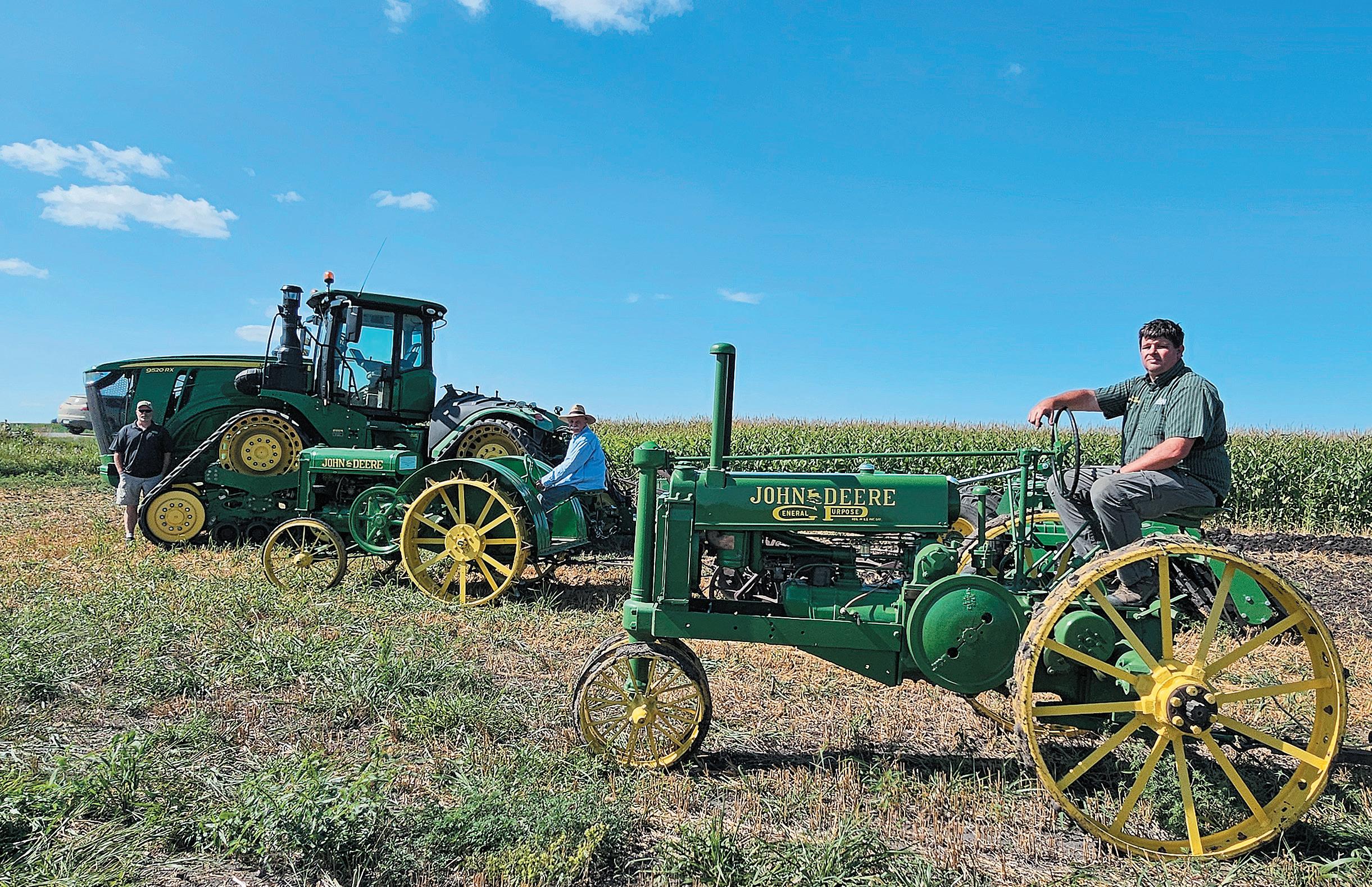
Continued from Page 1A
tractor brands of the era, noted the Smithsonian Museum of American History, which has a John Deere Model D tractor in its collection.
The John Deere Model D offered power, sturdiness, reliability and simplicity — all contained in the smaller size tractor that farmers wanted. It remained in production for 30 years.
From 1923 to 1953, roughly 160,000 Model D’s were built, according to Farm Collector.
This year was the first time that Cobler’s John Deere Model D made an appearance at the Albert City Threshermen and Collectors Show.
“This show featured some of the rarest John Deeres you’ll ever see,” Cobler said.
preservaTionisTs helped
This model d survive
One of the most sought-after variations of the Model D has a spoked flywheel like Cobler’s tractor. The first Model D’s built had a spoked flywheel, most likely a hold-over from the Waterloo Boy design. These flywheels proved problematic, however, with many cracking around the keyway.
Deere switched to a thicker, 24-inch-diameter flywheel, but this didn’t improve the design. In 1926, Deere switched to a solid flywheel, according to ClassicTractorsTV. com.
Cobler’s 1924 Model D is a true survivor. The tractor likely wouldn’t exist today, had there not been three key preservationists who intervened through the years, starting with one of the tractor’s earliest owners.
“This tractor got saved way back then because of a farmer fix on the flywheel,” Cobler said.
The second preservationist who kept this particular Model D’s history alive was Stan Reynolds from Wetaskiwin, Alberta, Canada. Reynolds (1923-2012) was a successful businessman and dedicated collector of vintage tractors and more. His generous contributions helped to preserve a wide array of agricultural, aviation, transportation and industrial heritage.
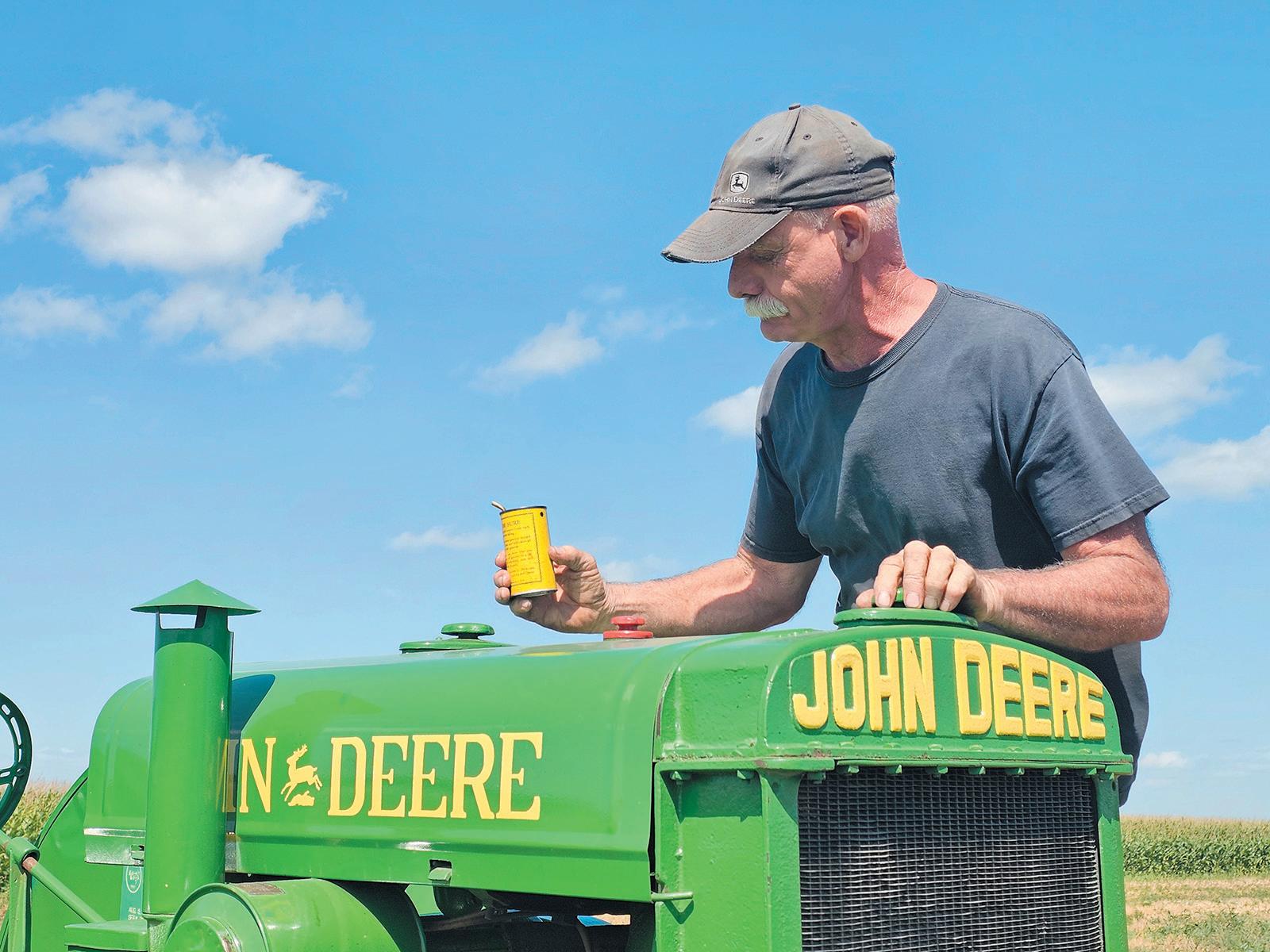
“Stan Reynolds was a Chevy dealer who started collecting vintage cars,” Cobler said. “He also started saving some of this old iron that was part of agricultural history.”
By 1955, Reynolds had acquired enough items to open the private Reynolds Museum to display some of the extraordinary items he had collected. In 1981, Reynolds made a substantial donation to the province of Alberta, including 850 important artifacts. This generous gift was the foundation for a new public facility operated by the Government of Alberta. The Reynolds-Alberta Museum opened in 1992.
About 35 years ago, the 1924 John Deere Model D that Reynolds helped preserve came up for sale. The Cobler family had been searching for a vintage Deere with a 26-inch flywheel. They saw an ad for a 1924 John Deere Model D in Engineers & Engines magazine.
Cobler’s father, Fred, paid $4,500 for this tractor and had the machine shipped to Ottumwa. “Today, this tractor would be worth about 10 times that much,” said Cobler, who inherited the tractor.
shoWcasing a cenTury oF progress
Cobler put the Model D to work recently in a field near the Albert City Threshermen and Collectors Show grounds. There’s no choke on the 1924 tractor, so Cobler had to prime it with fuel. There’s also no starter, so he had to manually turn the flywheel.
Once the tractor roared to life, Cobler did some plowing with the vintage iron.
He was joined by Travis Mullenger, 38, of Manning, who pulled a plow with his 1934 John Deere Model A.
“I wanted to collect a Model A every year the Model A was produced, from 1934 to 1952,” said Mullenger, whose family members have an extensive vintage tractor collection.
Matt Pohlman also did some tillage, following Mullenger and Cobler. Pohlman, a salesman for KC Nielsen Equipment in Laurens, was driving a 2018 John Deere 9520RX — a 520 horsepower machine that costs around $430,000.
OGDEN — Mark Muench, proprietor of Muench AgriSolutions — Iowa’s largest Salford tillage equipment dealership, will host a field day on his farm, 445 F Ave., Ogden, on Sept. 11.
Demonstrations of Salford models will take place from 2 to 4 p.m. that day on 20 acres, giving guests the opportunity to see the tillage pieces in action. The team will be serving lunch on the farm from 11:30 a.m. to 1 p.m.
A farmer himself, Muench recognizes the soil is his greatest asset. Tillage equipment can help prepare excellent seedbeds while caring for soil in the process.
“I was taught to take care of soil like it’s a child or family member, to never abuse it. And farmers need good yields to stay in business,” Muench said.
After testing several types of tillage equipment on his Boone County farm, Muench determined Salford products were far superior to other options. In the fall of 2012, he became a Salford equipment dealer, running the business out of his farm shop, selling his first machine in 2013. And today, his dealership is Iowa’s largest for the Canadian-owned manufacturer with a warehouse in Osceola.
“All of the machines we offer are high speed, covering a lot of acres,” Muench said. “That translates to time savings, fuel savings,

simplicity, and yields just as good or better with less effort.” That efficiency proves beneficial when corn prices are below $4 per bushel, or higher. Beyond efficiency, Muench says Salford tillage machines prepare an optimum seedbed. He and his team work with customers to determine the best Salford model for their needs. Their experience allows them to customize set up, so their customers’ machines are ready to roll upon delivery. This includes success in less-than-ideal field conditions.
“Salford will run when others can’t due to residue,” Muench said. Muench’s team includes full-time sales and service reps. They offer a perspective other dealers can’t because they run Salford machines, know them, and understand them. Muench and his wife, Holly, have two sons with interest in being the next generation on the family farm. Muench AgriSolutions, along with the farm, are enough to keep family and long-term employees sustainable while paving the way for future growth.














